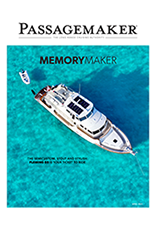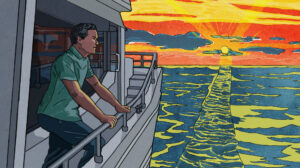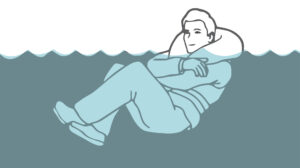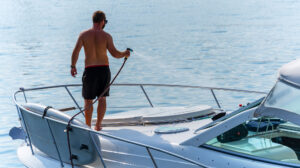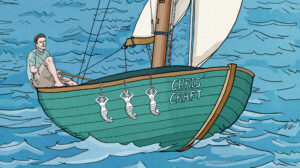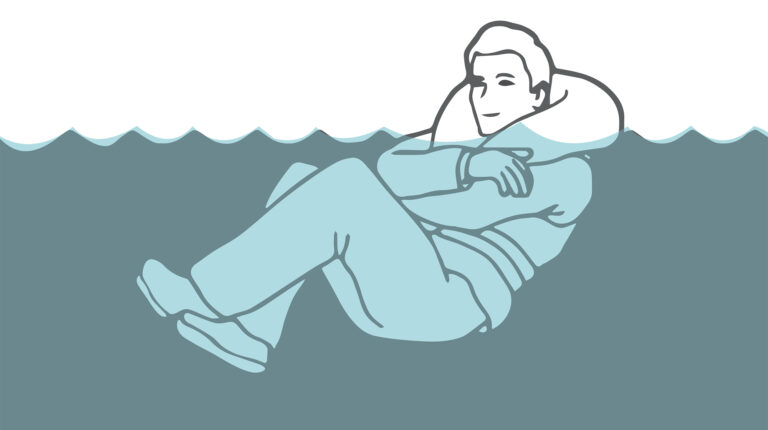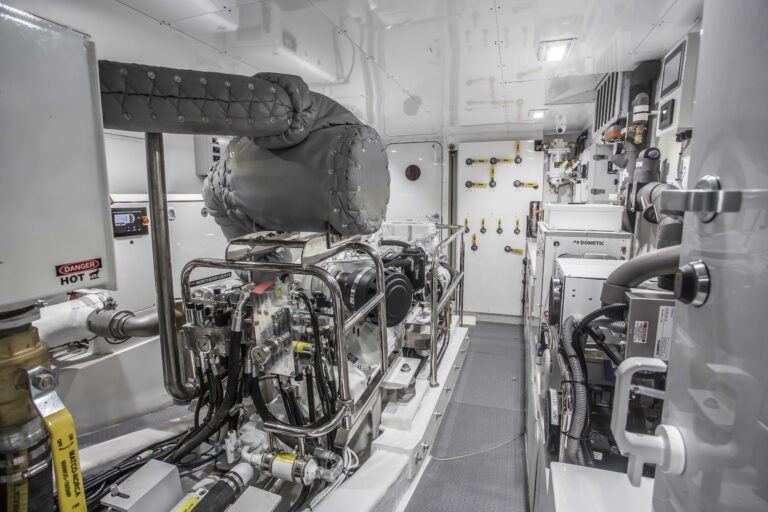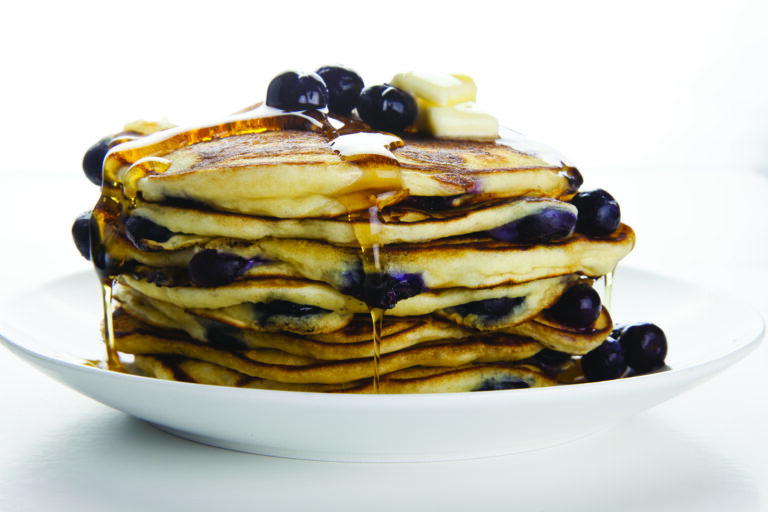
Ford and Janice Griswold were out on Puget Sound in Washington state, relaxing aboard a friend’s Polycraft 60. It was July Fourth a half-dozen years ago, and the experience was magical: great weather, comfortable cruising, boats of all kinds everywhere they looked.
“We looked at each other like, ‘Oh my God, this is so cool. We have to figure out a way to do this,’” Ford recalls.
They started shopping boat shows. Janice had grown up on the water, cruising as a child aboard her parents’ Uniflite 36, while Ford’s grandfather had been a commodore of the New York Yacht Club, giving Ford the chance to hang out as a kid with the crew of the America’s Cup yacht Courageous. The couple, as adults, felt like they could hold their own while shopping the docks. They just had to learn all the new lingo and systems.
“If we had bought a boat day one, we would’ve bought a boat with Volvo Penta IPS drives,” Ford says. “We figured it was the wave of the future: It’s easy-peasy with the joystick. It slides right into the slip.”

Then, they did some actual cruising and realized they wanted an entirely different type of boat. They booked a few charters with NW Explorations, a Bellingham-based company they’d seen at boat shows offering a fleet with the brand names Sabre, Grand Banks, Defever, Kadey-Krogen and Grand Banks. After chartering on those boats a few times, they thought they would buy a Grand Banks Europa. They liked the semi-displacement hull and the ability to cruise at 18 or 20 knots.

Until they did a flotilla charter with NW Explorations, spending more than just a few days aboard.
“We changed our minds,” Janice says. “Being on board for two weeks, for me, I wanted a different sleeping arrangement from the forward master. NW Explorations suggested we take a look at a classic with a full master stateroom in the back.”
Today, they are the happy owners of a boat that wasn’t even on their initial list—a 2001 Grand Banks 46 Classic—and have joined the ranks of countless owners who started out as charter clients and used the vacation process as a shopping tool.
Brian Pemberton, the founder of NW Explorations, says that almost all of the 15 or 16 boat owners in the company’s fleet got their start booking charters to see what they liked. Lisa McLean, marketing manager for Canada-based Le Boat river cruises, says people sometimes book for three or four weeks at a time there or in Europe to see how they fare while cruising an entire region. Barb Hansen, owner of Southwest Florida Yachts in Fort Myers, says about a quarter of the people who charter her company’s Grand Banks, Mainship, Beneteau Swift Trawler and other boats are thinking about becoming owners.

And they’re the smart ones, Hansen says. Anyone seriously shopping for a boat, in her opinion, should spend at least two or three weeks aboard chartering first.
“I can’t believe the people who balk at the cost,” she says. “Say it’s $5,000 for the week. I say, ‘You’re going to go spend $400,000 on a boat, and you don’t want to spend $5,000 or $10,000 to see if it’s going to be the right thing for you?’ I mean, how many people do you know who buy a boat and then in a year, it’s up for sale? This is the smart thing to do.”
Chartering is also a smart way to enhance cruising skills while thinking about becoming an owner in the future. Mark Allyn, who with his wife, Dorothy, owns a Malibu day boat on a lake near Austin, Texas, has been chartering sailboats in the Caribbean and French Polynesia since 1980. They “went over to the dark side,” as he puts it, about four years ago after a fellow student in his U.S. Coast Guard captain’s class mentioned how beautiful it was to cruise in the Pacific Northwest.

They booked a Defever 55 with NW Explorations. It was the first powerboat they’d ever chartered, and it started them on a path of becoming increasingly confident powerboaters. From bareboating, they moved into the company’s flotilla charters, which include a group captain for all the bareboaters to lean on with questions along the route.
“We fell in love with the boat and thought about buying it,” Allyn says of the Defever. “We did a flotilla charter with them on a Kadey-Krogen 58, and that was a super experience. You’re going places you would never go on your own—maybe the currents are a little too tough, or it’s just the distance—we joined it on leg six last year in Ketchikan [Alaska] and went down to Bellingham, and that was a little over three weeks. That’s when we fell in love with being on a boat more than two weeks. This year, we chartered a Defever 55 for three weeks and did Desolation Sound by ourselves. It was wonderful.”
Now, the couple are starting to think about the possibility of more than just chartering a few weeks at a time. They’re talking about staying home in Texas for half the year and living aboard a boat for the other half.

“You say, ‘Hey, can we really do this?” Allyn says. “Well, when you’re out there for three or four weeks, you’re refueling. You’re doing laundry. We’re thinking, Hey, living aboard? We could do this.”
Like the Allyns, most charter clients at NW Explorations are boat owners from outside the Pacific Northwest, Pemberton says. About 10 percent to 15 percent come from beyond U.S. borders; the rest are Americans who want to cruise in Alaska or the Pacific Northwest without moving their own boats there.
“Most of them are trawler types, either Grand Banks owners, Fleming owners, some of them are sailors,” Pemberton says. “It’s an easy transition going from a sailboat to a Grand Banks. We certainly get a Bayliner or Carver owner who comes with us too, but the majority are trawler owners, sailors and some people who have go-fast boats.”

Hansen says a lot of boat owners come through Southwest Florida Yachts, too. Some are looking to spend time aboard a certain brand of boat before buying, even if the model they charter isn’t a perfect match.
“It may not be the exact boat they want, but they can get a feel for the size, the systems, the brand, whether they can handle the maintenance—there’s all kinds of things that chartering or taking the classes can do for people,” Hansen says. “We get people all the time after our classes saying, ‘Wow, we didn’t know what we didn’t know.’ Maybe they run a little powerboat on a lake or something, and they call us and say they want to charter a 55-footer. And we have to say, ‘Well, it’s not quite the same…’”

The Griswolds have learned that lesson and then some. Having graduated from charter clients to owners, they’re now planning to take their Grand Banks through the Gulf Islands to Canada and then up to Desolation Sound next fall.
“Eventually, we’ll take it out of the charter fleet and take a summer on it, go up to Alaska and back,” Ford says, adding that chartering made all the difference for their shopping experience. “Those charters are one-week test drives. Had we jumped at the first purchase opportunity, we would’ve bought the wrong boat.”
Think Bigger

Wondering what it would be like to push the boundaries of an owner-operated, go-anywhere motoryacht? Maybe even add a crew member or two to your cruising lifestyle? The 63-foot Nordhavn Asturias, a 2017 build, offers a taste of that reality. She is part of the charter fleet at Superyacht Sales & Charter at a weekly base rate of $25,000 for six guests. The rate includes a captain and one other liveaboard crewmember. The yacht’s owner is open to letting clients book itineraries longer than a week in the outer islands of the Bahamas this winter, and in New England during the summer.
Money Matters
Charters are priced in various ways that let you do as little or as much of the actual boating work as you please. There are bareboats, which means you are your own captain, chef and crew, and your charter rate generally only covers the use of the boat. A flotilla charter usually means you’re paying for the boat plus access to a fleet-leading skipper and maybe a nature guide shared among the boats in the group. A captain-only charter means you get the boat and your own liveaboard skipper, while a crewed charter means you’re a guest and there’s a crew living aboard to do everything, including cooking your meals. Pay attention to the fine print: Crewed charters can be marketed as base rate only (just the boat and crew, with food and drinks being charged as extras) or inclusive (meaning the advertised rate covers the boat, crew, meals, ship’s bar and most other expenses).
